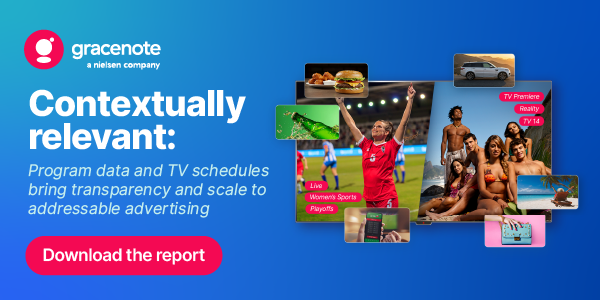TV audiences are rallying around CTV, and advertisers are following suit[1]. But with this shift comes a persistent challenge: How can advertisers ensure brand safety, campaign efficiency and audience relevance in a fragmented, opaque streaming ecosystem?
The answer may lie in metadata. Rich, contextual signals – like content genre, theme, tone, setting and even character archetypes – provide the transparency needed to make informed, cross-platform media investment decisions in streaming CTV while ensuring series-level targeting and brand suitability.
Why metadata matters in CTV advertising
CTV remains one of the hardest channels to validate. Unlike traditional linear TV, streaming platforms often don’t expose show-level data, making it difficult for buyers to understand where their ads are running. That’s where metadata steps in.
By layering in show-level and thematic metadata, advertisers gain the ability to align ad placements with specific types of content, ensuring better brand suitability and more effective storytelling. It’s not just about demographics anymore. It’s about content context.
Although contextual targeting is far from new, evidence of its success in the streaming CTV space is scarce. But two recent Gracenote direct-to-consumer (DTC) campaigns – one from a CPG brand and another from a wellness company – showcase what’s possible when content intelligence is brought into the ad-buying process.
Each campaign involved a DTC brand looking to grow through streaming CTV.
In the first case, a CPG brand used metadata to extend the reach of a major Super Bowl campaign into premium streaming placements. By focusing on high-profile live sports content, including March Madness, the brand ensured both brand safety and contextual relevance, which were key drivers of trust and attention.
The other campaign, a natural supplement brand, sought to increase its reach and engagement beyond its existing efforts on traditional linear television. Rather than relying on genre-level targeting, the brand’s team worked with partners to identify programming with specific themes, moods and narratives that resonated with its audience. This more nuanced approach led to a near-perfect video completion rate and more efficient cost-per-acquisition than pure user-level targeting.
From point solutions to strategy shift
What’s notable here isn’t just the use of metadata but the mindset. Advertisers are starting to view contextual intelligence as a foundational part of their streaming strategy. That shift has implications beyond individual campaigns.
For one thing, agencies can now deliver more tailored audience strategies across platforms. Publishers can monetize inventory more effectively by exposing rich metadata. And tech partners can enable transparency in increasingly automated buying environments.
As the streaming market grows more crowded and more fragmented, contextual signals will become a strategic differentiator. Brands want to know not just who is watching, but also what they’re watching and whether the surrounding content amplifies or undercuts their message.
Metadata can help answer those questions. As tools and standards evolve, expect content context to become as critical to CTV media planning as audience segmentation has been in digital.
The message for advertisers is clear: if you’re not factoring in content context, you’re not seeing the full picture.
[1] eMarketer expects video CTV ad spend to surpass $32 billion.
For more articles featuring Bill Michels, click here.















